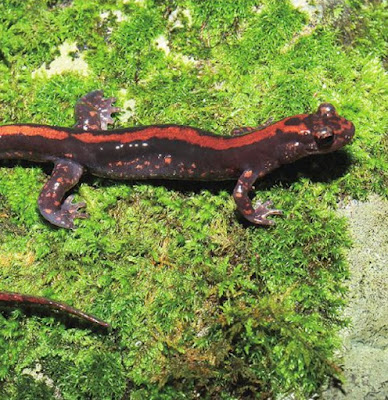 |
| Onychodactylus pyrrhonotus Yoshikawa & Matsui, 2022 |
Abstract
The number of species of salamanders of the genus Onychodactylus in Japan has increased from one to six nominal species over the past decade, by taxonomic studies based not only on morphological but also molecular phylogenetic data. However, the presence of an additional cryptic species has been suggested by a series of previous studies. Here, we describe a new species, Onychodactylus pyrrhonotus sp. nov., from the Kinki, Chubu and Hokuriku Districts of central Honshu, Japan, based on morphological and genetic evidence. It belongs to the O. japonicus species complex and is the sister species of O. kinneburi from Shikoku Island and westernmost part of Honshu with 5.5% sequence divergence in the mitochondrial cytochrome b gene. The range of the new species completely overlaps with that of O. japonicus sensu stricto, and they are syntopic in at least six known localities. As shown in a previous study, reproductive isolation between these sympatric species is substantial. The new species is morphologically most easily distinguished from congeners by coloration, a sharply defined scarlet to pinkish dorsal stripe or mottling on a black background and dusty white dots on the venter.
KEYWORDS: Central Honshu, Japan, Onychodactylus japonicus, Onychodactylus pyrrhonotus new species, Salamander, sympatry, taxonomy
 |
| Male holotype of Onychodactylus pyrrhonotus sp. nov. (NSMT-H 13600) in life. |
Onychodactylus pyrrhonotus sp. nov.
(Suggested English name: Fireback Clawed Salamander)
(Suggested Japanese name: Homura-hakonesanshou-uwo
「ホムラハコネサンショウウオ」)
「ホムラハコネサンショウウオ」)
Diagnosis: The new species is a member of the genus Onychodactylus and is diagnosed by the following characters: lungs absent; black horny claws present on tips of fingers and toes of larvae and breeding adults in both sexes; vomerine teeth in two short, transverse, arch-shaped series; larvae with skin folds on posterior edges of limbs; nuptial males with dermal flaps on posterior edge of hindlimb; black tubercles and asperities on palm and sole in nuptial males and on sole in nuptial females; breeding in flowing water under the ground; eggs large, pigmentless, small in number. It is further assigned to a member of the O. japonicus species complex by the genetic evidence and presence of a distinct dorsal stripe or marking. Onychodactylus pyrrhonotus sp. nov. is most similar to O. kinneburi, but differs in morphology (smaller body, fewer presacral vertebrae, wide internarial distance relative to head width) and coloration (scarlet, orange or pink dorsal stripe or marking on purplish black background; purplish gray ventrum with dusty white dots). Body size moderate with mean SVL (±1 SD) of 65.7±3.2 mm and 70.7±5.2 mm in males and females, respectively; tail longer than SVL in both sexes; snout relatively short; pair of dark marking on chest absent or indistinct; presacral vertebrae including atlas usually 18; costal grooves 12–13.
Etymology: The specific epithet, combination of ancient Greek words “pyrrho-” (fire-colored) and “-notus” (back), is derived from the beautiful scarlet dorsal coloration of the new species, and is also inspired from the coloration like the venter of the Japanese fire-bellied newt, Cynops pyrrhogaster.
The suggested English name is after the specific epithet. The suggested Japanese name is derived from a Japanese word “Homura (flame)” 「火の色の背中」.
Range: Onychodactylus pyrrhonotus sp. nov. is currently known from Kyoto, Mie, Nara, and Shiga Prefectures of the Kinki District, Ishikawa and Fukui Prefectures of the Hokuriku District, and Gifu Prefecture of the Chubu District, all in central Honshu (Fig. 1). To date, the new species is not known from Wakayama Prefecture in the southern Kii Peninsula, but it probably occurs in the area. The geographic range of the new species overlaps entirely with the entire geographic range of O. japonicus, and they are sympatric in at least six localities (Fig. 1).
Natsuhiko Yoshikawa and Masafumi Matsui. 2022. A New Salamander of the Genus Onychodactylus from Central Honshu, Japan (Amphibia, Caudata, Hynobiidae). Current Herpetology. 41(1); 82-100. DOI: 10.5358/hsj.41.82




